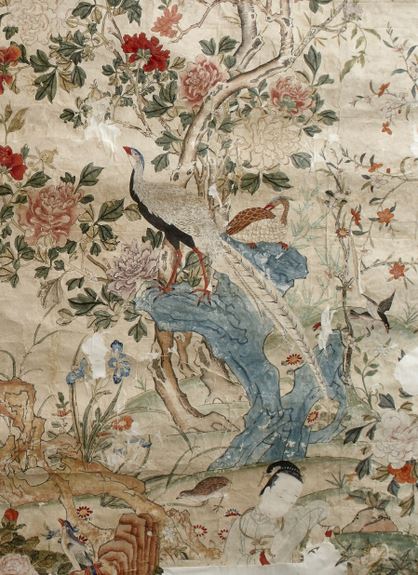Emile de Bruijn, Registrar at the National Trust, is a heritage professional who uncovers many of the hidden gems found throughout the vast Trust collection. He documents and posts his latest findings through his blog National Trust Treasure Hunt. Emile has agreed to let Royal Oak share his posts here, on AngloFiles for you, our members. Sign up for Emile’s emails on his blog to stay connected with the latest findings in the National Trust’s collection.
Enjoy below Emile’s descriptions of select Asian heirlooms.
In the collection at Uppark, West Sussex, are some fascinating fragments of Chinese wallpaper, which emerged from beneath a later wallpaper after a fire in 1989. Apart from being stunning examples of Chinese woodblock printing (with colours added by hand), they also contain clues about how Chinese wallpapers spread through Europe in the mid eighteenth century.

Fragment of Chinese wallpaper at Uppark, West Sussex, showing how parts of various Chinese prints were added at the bottom. NT 138490. © National Trust/Paul Highnam
This section of wallpaper shows a pair of pheasants on a picturesque rock surrounded by peonies and other flowering plants and trees. These ‘scholar’s rocks’ (gongshi) have long been used in Chinese gardens as sculptural ornaments. In the Chinese visual tradition, pheasants are associated with ‘beauty’ and peonies with ‘rank’.

Ribbon-tailed bird (shoudainiao) in a print attached to the bottom of a Chinese wallpaper sheet, at Uppark, NT 138490 © National Trust/Paul Highnam
Most of these specifically Chinese references were lost on Europeans, but this did not prevent these wallpapers from being in high demand. To make this rare and expensive material fit specific walls, the paper-hangers deployed various ‘cutting and pasting’ techniques’, shrinking or expanding it as required.

Head and shoulders of a female figure collaged onto a section of the Chinese wallpaper at Uppark, NT 138490. © National Trust/Paul Highnam
Looking closely at this fragment, we can see that parts of various different prints have been added at the bottom edge. On the left is a ‘ribbon-tailed bird’ (shoudainiao) on a scholar’s rock, depicted at a smaller scale than the main scenery, and in the centre we can see the head and shoulders of a female figure. Such prints could be bought in London in the same shops and paper-hanging establishments that offered Chinese wallpapers.

Section of the Chinese wallpaper at Ightham Mote, Kent, NT 825922. © National Trust/Paul Highnam
Looking further afield, we find the same pair of pheasants at Ightham Mote, Kent. The wallpaper was clearly printed using the same woodblocks. The difference in colour is due to the diverging ‘biographies’ of the wallpapers: the one at Uppark remained covered up for much of its life, preserving its colours to a greater degree, while the one at Ightham was partly overpainted in about 1900 in an attempt to counteract the effects of ageing and damp.

Part of the Chinese wallpaper at Ightham Mote, showing how it was arranged slightly differently to the paper at Uppark. NT 825922. © National Trust/Paul Highnam
Yet another identical pair of pheasants survives at Schloss Wörlitz in Sachsen-Anhalt, Germany, and copies of the print with the ribbon-tailed bird (actually showing a pair of birds) are at the Château de Filières, in Seine-Maritime, France. The whole of Europe was agog at these sophisticated Chinese products. More about these wallpapers and prints and other related examples will be revealed in my forthcoming book Chinese Wallpaper in Britain and Ireland.




